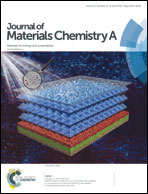The photo-, electro- and photoelectro-catalytic properties and application prospects of porous coordinate polymers
Abstract
Since the discovery of metal–organic frameworks (MOFs), covalent–organic frameworks (COFs) and zeolite–imidazole frameworks (ZIFs), many of their outstanding properties have been explored such as their large specific surface area, significant gas adsorption, and high catalytic activity. Some kinds of porous coordination polymers (PCPs) and their derivatives have shown high photocatalytic or electrocatalytic activity; thus, they may be able to catalyze the degeneration of organic molecules, the production of hydrogen and oxygen, carbon dioxide reduction, and so on. This review mainly focuses on the electrocatalytic, photocatalytic and photoelectrocatalytic properties of PCPs including MOFs, ZIFs and COFs. Several experiments have been reported in this article to compare their catalyst properties. Moreover, the reasons why they show these differences have been analyzed. These PCPs can be applied for tackling environmental pollution in water, carbon dioxide reduction and the production of hydrogen, which can help solve the energy crisis, the greenhouse effect and facilitate the utilization of solar energy.

- This article is part of the themed collection: Recent Review Articles


 Please wait while we load your content...
Please wait while we load your content...